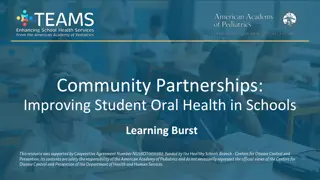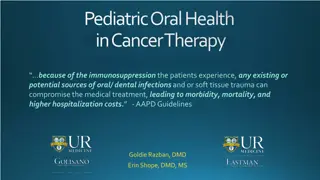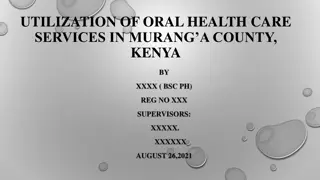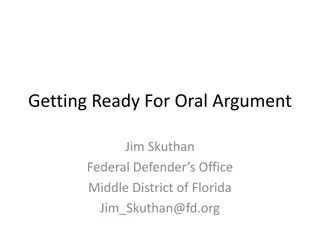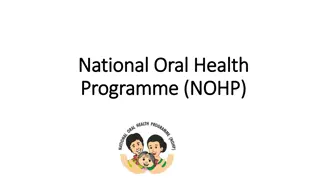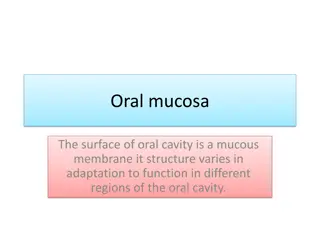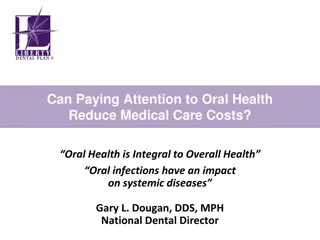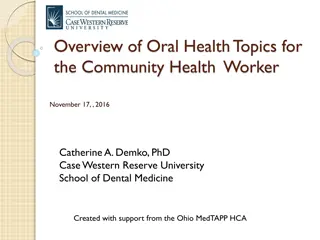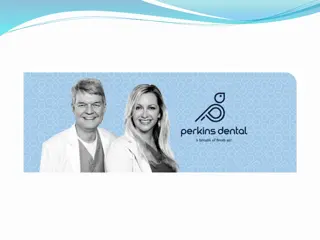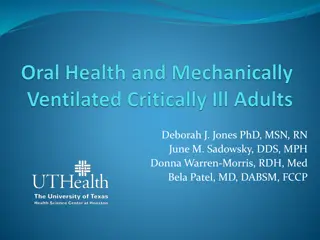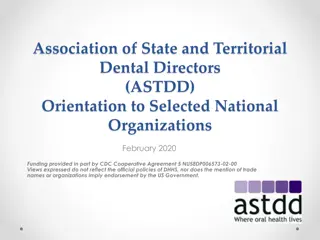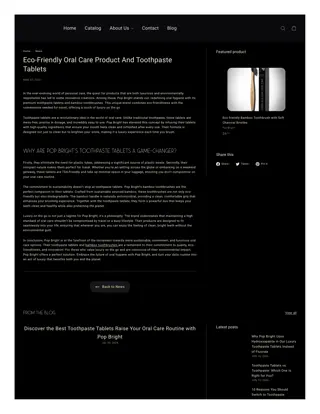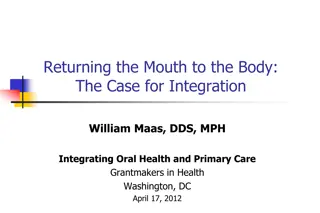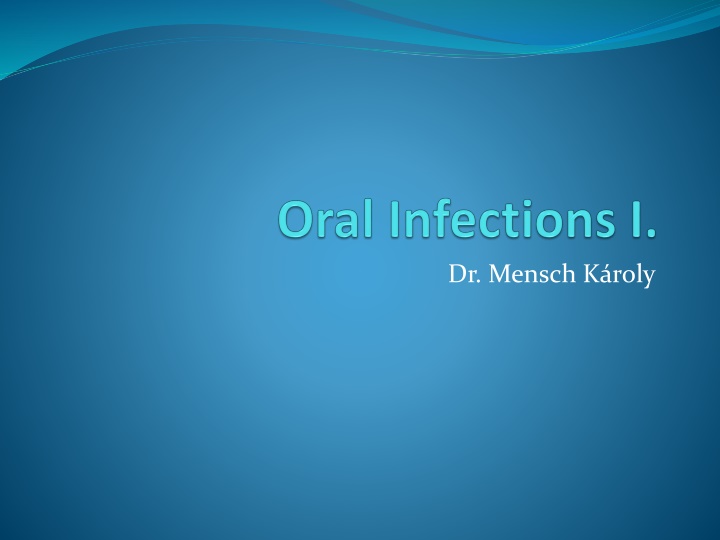
Oral Infectology and Nosocomial Infections in Dentistry
Explore the significance of oral infectology in dentistry, focusing on the etiology, symptomatology, diagnostics, prevention, and treatment of infectious diseases. Learn about common oral infectious diseases, the impact on quality of life, and the role of dentists in preventing nosocomial infections. Stay informed about the evolving landscape of infectious diseases and the importance of health awareness in today's world.
Download Presentation

Please find below an Image/Link to download the presentation.
The content on the website is provided AS IS for your information and personal use only. It may not be sold, licensed, or shared on other websites without obtaining consent from the author. If you encounter any issues during the download, it is possible that the publisher has removed the file from their server.
You are allowed to download the files provided on this website for personal or commercial use, subject to the condition that they are used lawfully. All files are the property of their respective owners.
The content on the website is provided AS IS for your information and personal use only. It may not be sold, licensed, or shared on other websites without obtaining consent from the author.
E N D
Presentation Transcript
Infectology The scientific discipline that studies the: - Etiology - Symptomatology - Diagnostics - Prevention - and Treatment of infectiousdiseases
Oral Infectology The scientificdiscipline that studies the: - Etiology - Symptomatology - Diagnostics - Prevention - and Treatment of oral infectiousdiseases , which can be - primary oral disease - systemic infection / disease associated with a condition
what is its significance? - The most common infectious diseases of the oral cavity: tooth decay and periodontal disease: ENDEMIC DISEASE BUT Often oral mucosal lesions are the main complaint - STOMATOONOLOGICAL SCREENING !!! - These changes often destroy the quality of life - These CAN BECOME life-threatening disorders - Sometimes difficult or unresolvableproblems (eg. mucosa involution at old age) psychiccomponents intensify
What can we do? - We refer the patient (we losea patient BUT sometimes it's better!) - We think wecan handle it .. (This is the worst) - Adequate treatment (there is not always a solution professional humility!)
Actuality The world is in constant progress: - pharmaceutical research vs. resistance - Vaccinations vs. Anti-vaccination campaigns - Health awarenessvs. irresponsible sexual behavior, travel opportunities - Other faactors: - wars - climate change - NOSOCOMIAL INFECTIONS
Nosocomial Infections Increasing danger! infectious hospital wards? Irresponsibledrug therapy Roleof thedentist: Prevention of nosocomial pneumonia! - It is lethal sometimes - supra-, subgingival depuration and curettage In case of planned hospital stay - CHX mouthwash significantly reduces the chance of nosocomial pneumonia during hospital stay! (Mensch K, Nagy G, Nagy A, Brody A. (2019) [Characteristics, diagnosis and treatment of the most common bacterial diseases of the oral cavity]. Orv Hetil, 160: 739-746.)
General Infectology factors that define the infection : - Location of infection, size of inoculum - Factorsof pathogen virulence - defense mechanisms of the host organism Differentconsequences : No colonization or infection occurs Colonization occurs when there is no response Infection occurs when there is a response
General Infectology Microbiome: The total amount of microorganisms found in the human body: 1015 1016 cells (vs. number of cells of the human body: 1014), it weighs 200 grams, but some authors say it can be 1400 grams Microflora: A collection of microorganisms that are specific to certain areas of the body and appropriate to the function of the organ. The various microfloraconstitute the microbiome. They perform defensive functions: irresponsible Ab Th can cause dysfunction
General Infectology Pathogen : - Obligatory: not a member of normal flora, it causes infection in case of a susceptible organism - Fakultative (optional): usuallya member of the normal flora, causes infection in case of certain risk factors - Opportunistic: member of the normal flora, infection occurs in case of reduced immunity. Often fatal!
Infectious diseases of the oral mucosa - problems They are usually less in the focus of general dental practice Occasionally, patients may have increased psychological stress Anamnesis, complaints, symptoms: What is the diagnosis ?
Common Mucosal Lesions: What Can They Be? - Mechanical irritation: sharp teeth, dentures, painful, acute - Aphta: Acute, painful ulcer - Signs of reflux on the mucous membrane (tongue tip, palate, discomfort, pain, usually acute) - LichenOID reaction: reticular pattern, something triggers it in the background (pain does not always occur) - Pre-cancerousconditions (painless, chronic) - Benign tumors (e.g.: Fibroma, painless) - Malignant tumors (painless, chronic) - Cystic disorders (acute or chronic, typically painful) - Symptoms of systemic diseases in the oral cavity (eg leukemia, coagulation disorders) - Mucosal manifestationsof dental inflammations (eg fistula, abscess, ANUG) - INFECTIONS!
Oral Infection - General History Age Childhood diseases (eg coxsackie, scarlet fever) Young adults (eg Mononucleosis, Herpes, HPV) Elderly age (eg: Candida) Immunodeficiency states (opportunistic infections!) Diabetes Asthma (steroid spray Candida) Recent Antibiotic Treatment (Candida) Upper respiratory tract infection has occurred(Strepto-, Staphylococcus) Increased stress (in case of death of a family member, during the exam period eg. Herpes)
Oral Infection?- dental history Poor oral hygiene ( upsets the microflora, more susceptible to infections) Incorrect fit of denture, mechanical irritation (denture stomatitis, bacterial superinfection) Is there a dead tooth? (Viewing, Knocking, Sensitivity, Touching the Periapical Area, X ray) SUBLINGUAL ABSCESS! Recent Dental Intervention (Micro Trauma superinfection, Herpes) The patient underwent Oral surgery recently (Herpes, Ab Th Candida)
Oral Infection?- Complaints Sincewhen? Bacterial infection: After dental treatment, if there is poor oral hygiene, after upper respiratory tract infection. Typically acute complaints. Viral infection: Frequent fever, severe pain, foetor, swelling of lymph nodes. It is usually ACUTE, but in case of e.g. HPV: it may persist for years ordecades Fungal infecton: Following antibiotic treatment, in case of steroid inhalers it may become ACUTE, often without complaints or mild discomfort, it is more often chronic.
Oral Infection?- Complaints Is thereany Pain? Yes/ No: often there is severe pain, eating and oral hygiene is hindered (eg. Bacterial infection, ulcer, Herpes, hand-foot- mouth pain, Chronic atrophic Candida, in case of papilloma: there is no pain) How long has the patient had it? Acute (rather bacterial, viral, if an adult has Candida + pharynx : HOSPITAL)/ Chronic (typicallyslight pain, discomfort) how much do you rate the pain on a 1-10 scale?
Oral Infection?- Complaints general state - oral infections are usually characterized by malaise, fatigue and sometimes COMMUNICATION is more difficult! - Fever: Acute, high fever often occurswith viral infections. Bacterial infection can lead to sepsis: septic fever !! LIFE THREATENING CONDITION You should also think about background disease! Eg: Pseudomembranous Candidiasis infection in Adults: Almost ALWAYS a symptom of a life-threatening general disease! - HIV ? - Leukemia ?
Oral infection?- Extraoral examination Viewing - General condition? Swelling (eg lipedema) Cheilitis angularis Examinationof lymph nodes (Infectionvs. Tumor)!!! MOBILe PAINFUL ACUTE HOT
Oral infection- Intraoral examination Oral hygiene Ulcers (often bacterial) Tiny blisters (eg. Herpes) Can it be wiped off? (Leukoplakiavs Candida) is it symmetrical? (eg. Herpes simplex MKO, Zoster: unilateral!) Localized / diffuse? Atrophia: Candida infection typically occurs in adults pseudomembranous: BACKGROUND DISEASE Is thereany exudate? Sublingual swelling, difficulty swallowing: SUBLINGUAL ABSCESS?
Work Diagnosis? history Oral examination Effectivenessof treatment If there is no progress? Additional examination!
Definitive Diagnosis Effectiveness of treatment during work diagnosis! If there is no improvement: Microbial Cultivation PCR Serology Blood test, Blood Chemistry: Blood sugar level Inflammatory parameters Blood analysis (Mensch K, Szarka K, Mensch H, Dobai A, Magyar Z, Pacurar M, Vartolomei AC, Manuc D, Dobo-Nagy C: PCR Technique Assisting the Early Diagnosis of Human Papillomavirus, REVISTA DE CHIMIE 69: (10) pp. 2781-2787.)
Bacterial infections of the oral cavity there are more than 600 strains of bacteria Gram positive / negative Aerobic / Anaerobic bacteria A significant number of them carry out important tasks Obligatoryoroptional pathogens Tooth decay Periodontal disease infections of the soft tissues tumors of the oral cavity?
Oral bacterial infections in childhood - Scarlet fever Pathogen : Streptococcus Pyogenes -haemolyticus it spreadsviaaerial infection Acute infection Bad general condition, fever, weakness, sore throat Hyperaemia, oedema, stomatitisscarlatina: : The tongue usually has an initially whitish coating, the tip and the edge are bright red Strawberry tongue: white coating disappears after a few days, red, granular, swollen tongue. DDg: diphteria, mononucleosis infectiosa, candidiasis
Oral bacterial infections in childhood - Diphteria Pathogen : Corynebacterium diphtheriae Vaccination, but there are more and more anti-vaccine campaigns General symptoms - fever, vomiting, asthenia, nervous and toxic symptoms Regional swelling of lymph nodes pseudomembranous ulcerson palate, pharynx, tongue, cheek and nose - maycause suffocation Differential diagnosis: Plaut-Vincentangina, herpangina, mononucleosis, measles
Diphteria www.healthland.com
Pyoderma around the mouth Furuncle (single hair follicle), Carbuncle (multiple hair follicles) St. Aureus complications: sinus cavernosus thrombosis, inflammation in the anastomosis region of V. Ophtalmicaand V. angularis LETHAL TRIANGLE"
Necrotizing fasciitis Severe pyoderma Str. Pyogenes, Sta. Aureus, Anaerobic bacteria One third of patients are alcohol addicts Diabetes predisposes it, common in the neck area, on the nape Odontogenic origin! Thrombosis ischemia, necrosis Gas Gangrene: Gases produced by anaerobic bacteria Crepitation is this a Background Disease ?! Requires immediate care (surgical, antibiotic), one third of the cases are fatal
Plaut-Vincent Angina Pathogen: Fusobacterium Plauti-Vincenti, Borrelia Vincenti in the oral cavity as a secondary infection after ulcerative gingivostomatitis Necrotic ulcers, foetor, enlarged lymph nodes, pain Ddg: ulcerative stomatitis , diphteria Scary but good prognosis
Plaut-Vincent Angina SE- F.O.G. Klinika
Ulcerative gingivostomatitis, ulceronecrotic gingivitis coinfection of anaerobic bacteria (Fusospirocheta) + Streptococcus Gums and mucous membranes may be affected Severe pain, fever, enlarged lymph nodes, foetor ex ore The tip of the gingival papilla is in a straight line covered with a yellow plaque, the area is inflamed there are similar ulcers on the palate and on the cheek It can also affect the bone tissues Therapy: Metronidazole, Amoxicillin, local disinfectants
Nonbullous impetigo (Impetigo contaginosa) Staphylococcus aureus, Streptococcus pyogenes Frequent, yellowish pustules and crusts that spread on the face It is formed by mechanical irritation Common among children Mucous membrane may also be affected: painful ulcers Ddg: Herpes Simplex, Herpes Zoster Therapy: Penicillin
Nonbullous impetigo (Impetigo contaginosa)
Syphilis - Pathogen: Treponema pallidum - Sexually Transmitted Disease - FREQUENT! - In the 1st stage: there are ulcerations (chancres) at the point of entry of the pathogen at the site of infiltration, the surrounding lymph nodes are enlarged. - In the 2nd stage: After 6-8 weeks, there are soft, white, slightly prominent spots on the mucous membrane, there are rashes, enlarged lymph nodes and anogenital warts with fever and laryngitis. It is extremely contagious for about 2 years! - In the 3rd stage: Glossitis can develop years later, the tongue papillae wither and become furrowed, leukoplasia can develop, often malignant! Ulceration, palate bone destruction. Symptoms of the vascular and nervous system can be observed besides the symptoms of the mouth. Therapy: Penicillin in high doses.
Bacteremia Dental interventions with bacteraemia! Supra and subgingival depuration, curettage Extraction, oral surgery Endodontic care Intraligamental anesthesia However: It can also occur when a patient with poor oral hygiene brushes teeth It occurs 30 seconds after the intervention, but no later than 10 minutes
Use of an antibiotics Prophylaxis vs. Treatment ? Prophylaxis! RESISTANCE!
Bacteria as an etiological factor in various cancers : Gastric carcinoma-Helicobacter pylori Bladder carcinoma-Salmonella typhi Cervical cancer-Chlamydia trachomatis Lung cancer-Chlamydia pneumoniae Intestinal tumors-Streptococcus bovis
data in literature - indicator bacteria : Shiga et al. (2001): Streptococcus anginosus, Mager et al. (2005): Capnocytophaga gingivalis, Prevotella melaninogenica, Streptococcus mitis Chocolatewala et al.(2010): Exiguobacterium oxidotolerans, Prevotella melaninogenica, Veilonella parvula, Staphylococcus aureus
Role of bacteria in oral carcinogenesis Through the induction of chronic inflammation Directly / indirectly Modification of eukaryotic cell cycle Influencing the signaling paths Carcinogenic metabolites - acetaldehyde, nitrosamines
Clinical application in case of appropriate marker bacteria (C. gingivalis, P. melaninogenica, and S. mitis) early diagnosis is possible Therapeutic options: Vaccination, Intracellular transport
Thank you for your attention!

